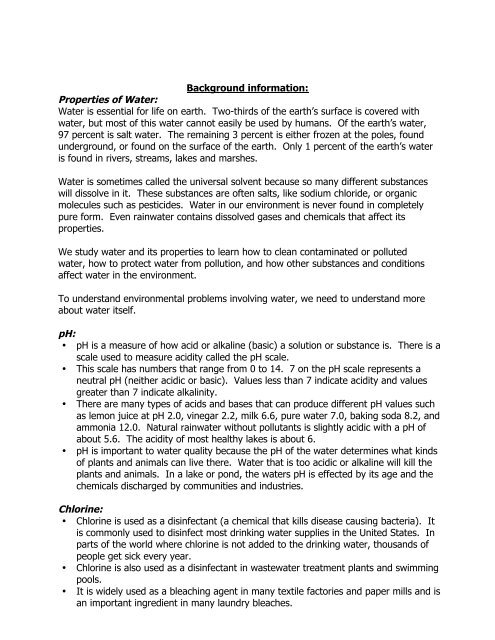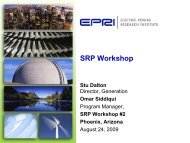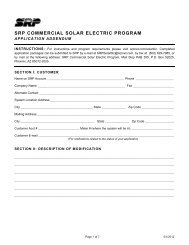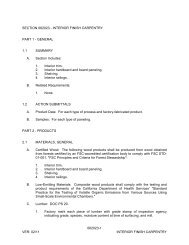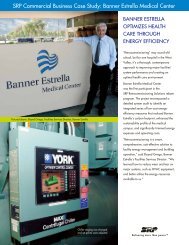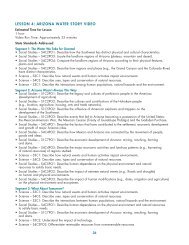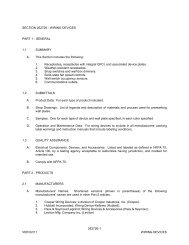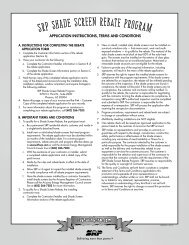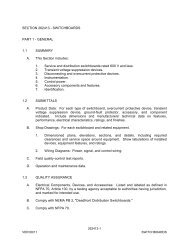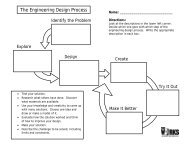How Do We Know What is Healthy Water? - Salt River Project
How Do We Know What is Healthy Water? - Salt River Project
How Do We Know What is Healthy Water? - Salt River Project
You also want an ePaper? Increase the reach of your titles
YUMPU automatically turns print PDFs into web optimized ePapers that Google loves.
Background information:<br />
Properties of <strong>Water</strong>:<br />
<strong>Water</strong> <strong>is</strong> essential for life on earth. Two-thirds of the earth’s surface <strong>is</strong> covered with<br />
water, but most of th<strong>is</strong> water cannot easily be used by humans. Of the earth’s water,<br />
97 percent <strong>is</strong> salt water. The remaining 3 percent <strong>is</strong> either frozen at the poles, found<br />
underground, or found on the surface of the earth. Only 1 percent of the earth’s water<br />
<strong>is</strong> found in rivers, streams, lakes and marshes.<br />
<strong>Water</strong> <strong>is</strong> sometimes called the universal solvent because so many different substances<br />
will d<strong>is</strong>solve in it. These substances are often salts, like sodium chloride, or organic<br />
molecules such as pesticides. <strong>Water</strong> in our environment <strong>is</strong> never found in completely<br />
pure form. Even rainwater contains d<strong>is</strong>solved gases and chemicals that affect its<br />
properties.<br />
<strong>We</strong> study water and its properties to learn how to clean contaminated or polluted<br />
water, how to protect water from pollution, and how other substances and conditions<br />
affect water in the environment.<br />
To understand environmental problems involving water, we need to understand more<br />
about water itself.<br />
pH:<br />
• pH <strong>is</strong> a measure of how acid or alkaline (basic) a solution or substance <strong>is</strong>. There <strong>is</strong> a<br />
scale used to measure acidity called the pH scale.<br />
• Th<strong>is</strong> scale has numbers that range from 0 to 14. 7 on the pH scale represents a<br />
neutral pH (neither acidic or basic). Values less than 7 indicate acidity and values<br />
greater than 7 indicate alkalinity.<br />
• There are many types of acids and bases that can produce different pH values such<br />
as lemon juice at pH 2.0, vinegar 2.2, milk 6.6, pure water 7.0, baking soda 8.2, and<br />
ammonia 12.0. Natural rainwater without pollutants <strong>is</strong> slightly acidic with a pH of<br />
about 5.6. The acidity of most healthy lakes <strong>is</strong> about 6.<br />
• pH <strong>is</strong> important to water quality because the pH of the water determines what kinds<br />
of plants and animals can live there. <strong>Water</strong> that <strong>is</strong> too acidic or alkaline will kill the<br />
plants and animals. In a lake or pond, the waters pH <strong>is</strong> effected by its age and the<br />
chemicals d<strong>is</strong>charged by communities and industries.<br />
Chlorine:<br />
• Chlorine <strong>is</strong> used as a d<strong>is</strong>infectant (a chemical that kills d<strong>is</strong>ease causing bacteria). It<br />
<strong>is</strong> commonly used to d<strong>is</strong>infect most drinking water supplies in the United States. In<br />
parts of the world where chlorine <strong>is</strong> not added to the drinking water, thousands of<br />
people get sick every year.<br />
• Chlorine <strong>is</strong> also used as a d<strong>is</strong>infectant in wastewater treatment plants and swimming<br />
pools.<br />
• It <strong>is</strong> widely used as a bleaching agent in many textile factories and paper mills and <strong>is</strong><br />
an important ingredient in many laundry bleaches.


